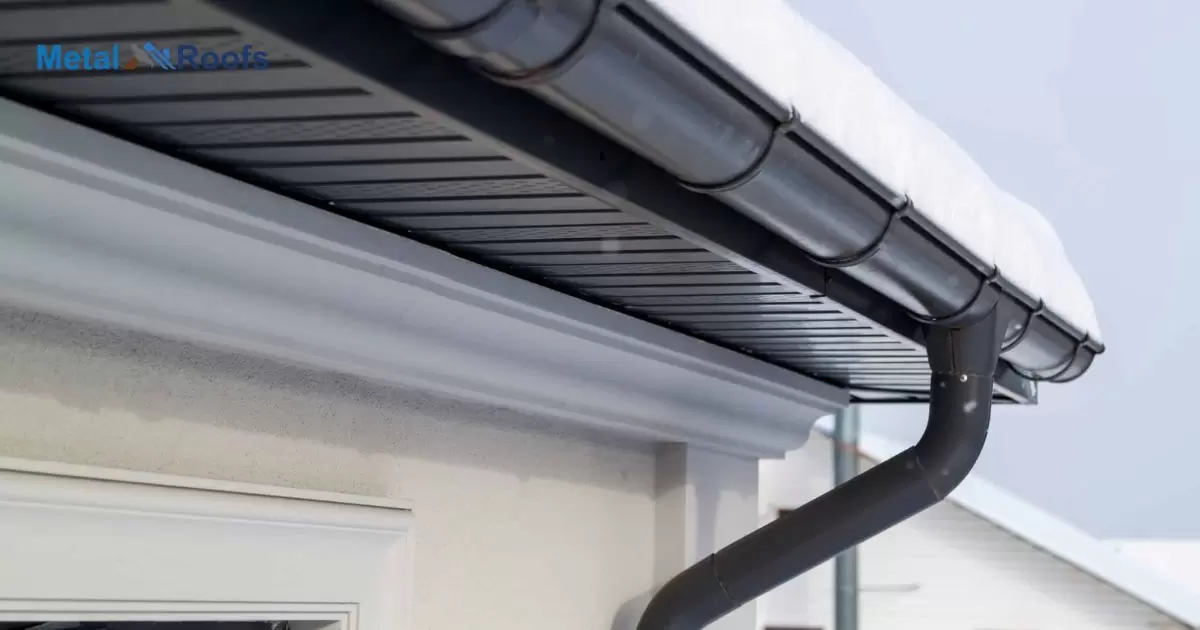Rain gutters collect and divert water off roofs, metal roofs need gutters to prevent leaks and rust gutters must be sloped and have ample downspouts to effectively carry large volumes of water from metal roofs.
Rain pouring off a metal roof can cause damage. Installing gutters prevents this. But how to install rain gutters with a metal roof correctly? Proper slope and ample downspouts are key. Materials must withstand weathering. Position matters too. Done right, gutters give years of leak-free service.
When installing gutters on metal roofs, carefully plan for water runoff over the Metal Roofing Over Plywood. Ensure precise placement, cut gutters to length, and secure them with proper slope. This safeguards the Metal Roofing Over Plywood when gutters are properly installed.
Key Takeaways
- Installing gutters on a metal roof demands attention to details like precise alignment and potential rust concerns.
- Seeking professional help is advisable for a seamless installation, especially when facing the unique challenges posed by metal roofing.
- Regularly clean gutters to prevent debris buildup and maintain proper water flow.
- Check for rust on metal gutters and apply rust-resistant paint to prevent corrosion.
- Periodically tighten fasteners, trim overhanging branches, and inspect for leaks to ensure long-term functionality and prevent water damage.
Why Install Gutters With Metal Roofing?
Installing gutters with metal roofing is crucial for effective water management. Metal roofs often have a steeper pitch, causing water to flow more rapidly. Gutters prevent water from cascading off the roof uncontrollably, safeguarding your foundation and landscaping.
Gutters enhance the longevity of metal roofs by preventing water-related damage. They channel water away, minimizing the risk of corrosion and rust on the roof panels.
Proper gutter installation ensures that your metal roof remains durable and efficient in all weather conditions.
Are Gutters Necessary For Metal Roofing?
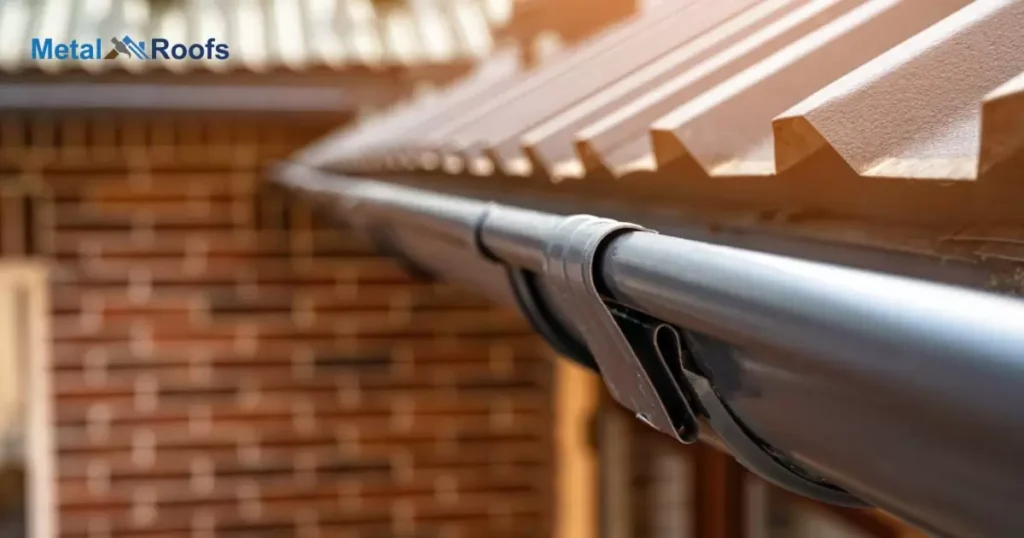
Gutters are crucial for metal roofing as they prevent water overshooting and causing potential damage. Without gutters, rainwater can harm landscaping, siding, and the foundation, impacting the building’s structural integrity.
Gutters protect against corrosion by directing acidic runoff away, ensuring the prolonged durability of metal roofing systems.
Benefits Of Installing Gutters On A Metal Roof
Water Control: Gutters on a metal roof prevent foundation damage and erosion by directing water away.
Aesthetic Preservation: They protect landscaping and siding, maintaining the property’s appearance.
Corrosion Reduction: Gutters redirect acidic rainwater, extending the metal roof’s lifespan.
Foundation Safety: Installation safeguards the foundation, contributing to overall structural stability.
Cost-Effective Investment: Gutters enhance functionality, longevity, and reduce the need for expensive repairs.
Challenges And Considerations
Installing gutters on a metal roof presents challenges. Consider the roof’s slope and material compatibility for proper drainage. Choose suitable hangers and ensure precise sealing for an effective gutter system.
How Are Gutters Attached To A Metal Roof?
Measure the roof’s edge and mark the alignment with a chalk line. Install gutter hangers along the line, securing them with screws. Attach the gutter sections, connect the downspouts, and seal joints with connectors for a secure installation on your metal roof.
Common Issues With Gutters On A Metal Roof
Installing gutters on a metal roof can be tricky due to its expansion and contraction. Ensure precise alignment for proper water flow and use materials that accommodate the roof’s movement.
Regular maintenance is essential to prevent leaks and maintain the gutter system’s effectiveness.
Choosing The Right Gutter System
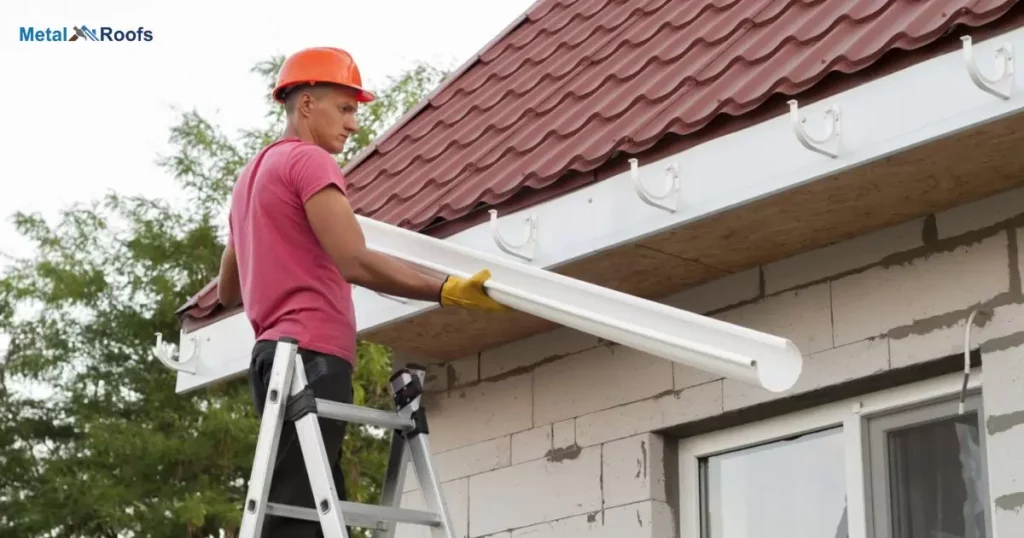
When selecting a gutter system for a metal roof, consider the material and durability. Opt for corrosion-resistant options like aluminum or galvanized steel to withstand the metal roof’s unique challenges.
Ensure proper sizing and installation by measuring the roof’s dimensions and slope accurately. Choose a gutter profile that complements the roof’s aesthetic while effectively channeling water away, preventing potential damage to your property.
What Are The Best Gutter Materials For Metal Roofing?
When considering the best gutter materials for metal roofing, durability is key. Opt for materials like aluminum or galvanized steel, as they are corrosion-resistant and well-suited to withstand the elements.
Aluminum gutters are lightweight, easy to install, and won’t rust, making them an excellent choice for complementing the longevity and low maintenance of metal roofing.
Similarly, galvanized steel gutters offer strength and resilience, providing an effective drainage solution for homes with metal roofs.
Selecting The Appropriate Style And Size Of Gutters
When choosing the right gutters for your metal roof, consider the style that complements the overall aesthetics of your home. opt for seamless gutters for a clean and streamlined look, or go for sectional gutters for easier maintenance.
Size matters in gutter selection; ensure they can handle the volume of rain in your region. Consult local building codes and climate conditions to determine the appropriate size that effectively channels water away from your roof and foundation.
Step-By-Step Installation Guide
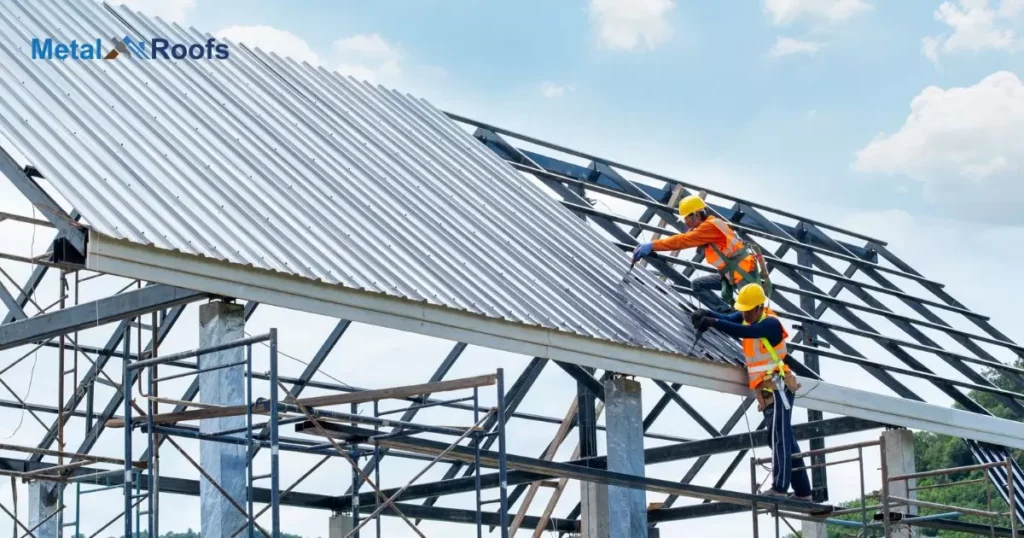
| Step | Action |
| 1 | Measure and mark the roof’s edge with a chalk line for gutter placement. |
| 2 | Attach brackets along the line, securing them with screws. |
| 3 | Install gutters, connect sections with connectors, add end caps. |
| 4 | Attach downspouts to complete the installation. |
| 5 | Ensure gutters have a slight slope towards the downspouts for efficient drainage. |
| 6 | Check alignment with a level to guarantee proper water flow towards the downspouts. |
Measure and mark the roof’s edge with a chalk line for gutter placement. Attach brackets along the line, securing them with screws. Install gutters, connect sections with connectors, add end caps, and attach downspouts to complete the installation.
Preparing The Metal Roof For Gutter Installation
- Begin by measuring the length of your roof’s edges where gutters will be installed.
- Use a chalk line to mark a straight reference line for proper gutter alignment.
- Install gutter brackets or hangers along the chalk line, ensuring they are evenly spaced.
- Attach the brackets securely to the metal roof using screws and a drill.
- Check the alignment with a level to guarantee proper water flow towards the downspouts.
- Ensure that the gutters have a slight slope towards the downspouts for efficient drainage.
- With the roof prepared, you are now ready to install the rain gutter sections.
Attaching The Gutters To The Fascia Board
To begin, position the gutter hangers or brackets on the fascia board, ensuring they are evenly spaced. Use a tape measure and level to achieve proper alignment.
Secure the hangers in place with screws, ensuring a sturdy connection between the gutters and the fascia board.
Installing The Downspouts For Proper Drainage
To ensure proper drainage, start by measuring and marking the optimal locations for downspouts on your metal roof. Use a chalk line to create a straight and level guideline for accurate installation.
Secure the downspouts with screws and brackets, ensuring they slope slightly towards the desired drainage point for efficient water flow.
Professional Assistance And Maintenance
For professional assistance in installing rain gutters on a metal roof, consider hiring a roofing contractor. They possess the expertise and tools to ensure a proper and secure installation.
Regular maintenance is crucial to keep gutters functioning effectively. Schedule periodic inspections and cleanings to prevent clogs and ensure water flows smoothly. Professional maintenance can extend the life of your gutters and protect your home from water damage.
When To Seek Professional Help For Gutter Installation
When it comes to installing gutters on a metal roof, seeking professional help is wise. The unique challenges of metal roofing, such as precise alignment and proper water flow, often require specialized knowledge.
Professional installers can ensure a trouble-free installation, minimizing the risk of leaks and preserving the long-term integrity of both the roof and the gutter system.
Tips For Maintaining Gutters On A Metal Roof
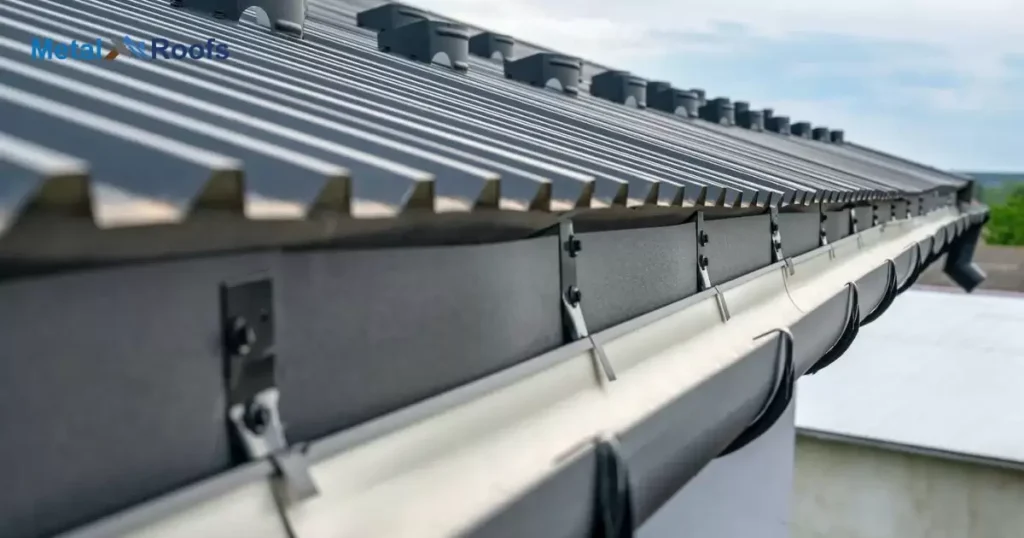
Regular Cleaning: Clean gutters periodically to remove debris and maintain proper water flow.
Inspect for Rust: Check for rust on metal gutters and apply rust-resistant paint to prevent corrosion.
Secure Fasteners: Tighten fasteners and hangers to ensure the gutters remain securely attached to the metal roof.
Trim Overhanging Branches: Trim branches to prevent debris buildup and protect gutters and the metal roof from damage.
Check for Leaks: Regularly inspect gutters for leaks, resealing joints promptly to prevent water damage.
Gutters On Metal Roof Problems
Installing gutters on a metal roof presents unique challenges. The metal’s slick surface can make securing gutters tricky. Fasteners must be chosen carefully to prevent corrosion and ensure stability. Without proper installation, leaks and water damage can occur.
Furthermore, debris accumulation is common with metal roofs, leading to clogged gutters. Regular maintenance is crucial to prevent blockages and ensure proper drainage. Hiring a professional for installation and maintenance can mitigate these issues and prolong the life of your gutter system.
Gutter K-Style
Gutter K-Style is a popular choice for many homes. It has a distinctive shape that resembles the letter “K”. This design allows for efficient water collection and drainage. The flat bottom helps prevent debris buildup, reducing the risk of clogs. Gutter K-Style is durable and can complement various architectural styles.
It’s easy to install and maintain, making it a practical option for homeowners. Proper installation ensures optimal performance, directing rainwater away from the house’s foundation. Regular cleaning helps prevent blockages and extends the gutter’s lifespan.
K Style Rain Gutters
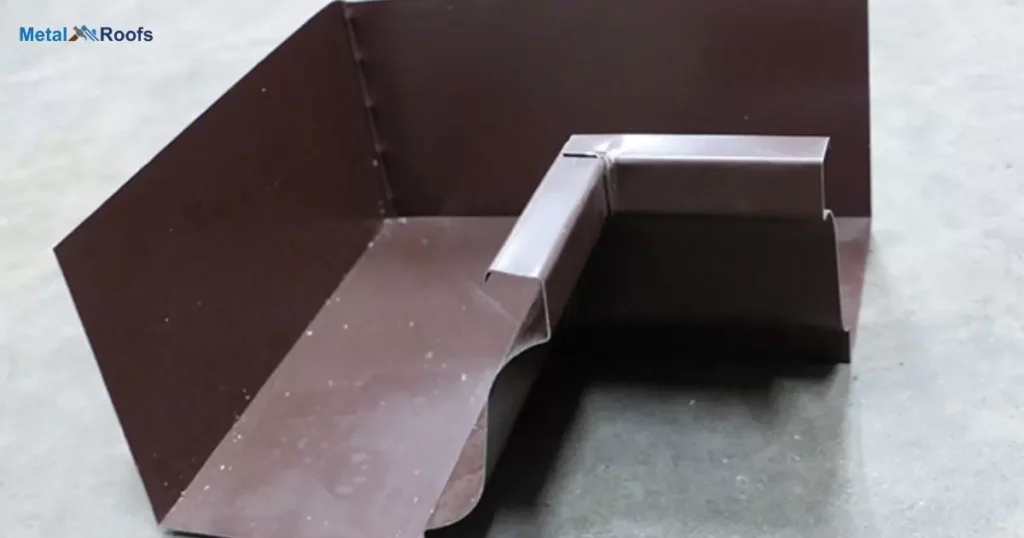
K style rain gutters are a popular choice for homes due to their efficiency in handling water flow. They feature a unique shape resembling the letter “K”, allowing for increased water capacity and debris resistance.
Installation involves attaching gutter hangers to the fascia board or rafter tails, ensuring proper slope towards downspouts. Downspouts and elbows are then connected to direct water away from the house, with joints sealed for leak prevention.
Frequently Asked Questions
Can you install gutters on a metal roof?
Yes, gutters can be installed on a metal roof. It’s essential to follow proper installation techniques to ensure a secure and effective gutter system.
How do you install gutter guards on a metal roof?
Secure gutter guards onto the metal roof by attaching them to the gutter edges using screws or clips. Ensure a snug fit to prevent debris from entering while allowing proper water drainage.
How should rain gutters be installed?
Rain gutters should be installed with proper alignment and a slight slope for water flow. Secure them with hangers or brackets, ensuring a sturdy attachment to the fascia or roof structure.
Conclusion
Gutters are crucial for metal roofs. Installed incorrectly, water pools and penetrates. Leaks cause rust and roof failure. Get professionally measured and mounted aluminum gutters. Maintain twice yearly by cleaning debris. Quality gutters protect investment.
Damaging water overflow is preventable. Following manufacturer guidelines matters. Calculate required length and slope. Mount securely to support weight.
Connect downspouts to drainage. Inspect sealants regularly. Functioning gutters mitigate cost of roof replacements. Protecting metal roofing leads to longevity.
